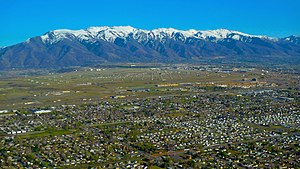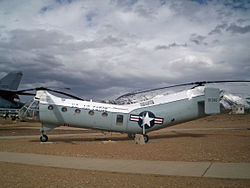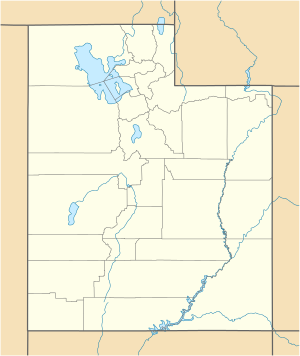Hill Air Force Base
This article needs additional citations for verification. (February 2013) |
| Hill Air Force Base | |
|---|---|
| Part of Air Force Materiel Command (AFMC) | |
| Located near: Ogden, Utah | |
 388th FW F-16 Fighting Falcons | |
| Coordinates | 41°07′26″N 111°58′22″W / 41.12389°N 111.97278°W |
| Site information | |
| Controlled by | |
| Open to the public | No |
| Site history | |
| Built | 1939 |
| In use | 1939–Present |
| Garrison information | |
| Garrison |  75th Air Base Wing 75th Air Base Wing 388th Fighter Wing 388th Fighter Wing 419th Fighter Wing 419th Fighter Wing |
Airfield information | |||||||||||
|---|---|---|---|---|---|---|---|---|---|---|---|
| Summary | |||||||||||
| Elevation AMSL | 4,789 ft / 1,459.7 m | ||||||||||
| Coordinates | 41°07′26″N 111°58′22″W / 41.12389°N 111.97278°W | ||||||||||
| Website | www.hill.af.mil | ||||||||||
| Map | |||||||||||
 | |||||||||||
| Runways | |||||||||||
| |||||||||||
Hill Air Force Base (IATA: HIF, ICAO: KHIF, FAA LID: HIF) is a major U.S. Air Force base located in northern Utah, just south of the city of Ogden, and near the towns of Clearfield, Riverdale, Roy, Sunset, and Layton. It is about 30 miles (48 km) north of Salt Lake City. The base was named in honor of Major Ployer Peter Hill of the U.S. Army Air Corps, who died test-flying a prototype of the B-17 Flying Fortress bomber. In this decade Hill AFB is still the sixth-largest employer in the state of Utah, and the third-largest one excluding the State Government and Higher Education employers.[1] Hill AFB is the home of the Air Force Materiel Command's (AFMC) Ogden Air Logistics Complex which is the worldwide manager for a wide range of aircraft, engines, missiles, software, avionics, and accessories components. The commander of the Air Logistics Complex is Brigadier General H. Brent Baker Sr. The Ogden Air Logistics Complex is part of the Air Force Sustainment Center.
The host unit at Hill AFB is the Air Force Material Command's 75th Air Base Wing (75 ABW), which provides services and support for the Ogden Air Logistics Complex and its subordinate organizations. The Wing and Installation Commander of Hill Air Force Base is Colonel Ronald Jolly. Additional tenant units at Hill AFB include operational fighter wings of the Air Combat Command (ACC) and the Air Force Reserve Command (AFRC).
Units
Main units
- Ogden Air Logistics Complex
Provides worldwide engineering and logistics management for the F-16 Fighting Falcon, A-10 Thunderbolt II, and Minuteman III intercontinental ballistic missile. - 75th Air Base Wing
Responsible for the base operating support of all units at Hill AFB. The 75th ABW provides base operating support for the Ogden Air Logistics Complex, the 388th and 419th Fighter Wings, the 84th Combat Sustainment Wing, the 309th Maintenance Wing, the 508th Aerospace Sustainment Wing, and 25 subordinate units.- 75th Civil Engineering Group
- 75th Medical Group
- 75th Mission Support Group
- 84th Combat Sustainment Wing
- 309th Maintenance Wing
- 508th Aerospace Sustainment Wing
- 526th ICBM Systems Wing
Tenant units
- 388th Fighter Wing (388 FW) of the Air Combat Command
- 388th Operations Group
- 4th Fighter Squadron
- 421st Fighter Squadron
- 34th Fighter Squadron
- 388th Operations Support Squadron
- Utah Test and Training Range
- 388th Maintenance Group
- 388th Operations Group
- 419th Fighter Wing (419 FW) of the Air Force Reserve Command
- 419th Operations Group
- 466th Fighter Squadron
- 419th Operations Support Flight
- 419th Maintenance Group
- 419th Operations Group
- 729th Air Control Squadron
Utah Test and Training Range
The Utah Test and Training Range is one of the only live-fire U.S. Air Force training ranges within the United States. It is located in far western Utah, close to the Nevada border, and it extends both north and south of Interstate Highway 80, with several miles of separation on each side of the Interstate Highway. The portion of the bombing range that lies north of Interstate 80 is also west of the Great Salt Lake. The Utah Test and Training Range lies in Tooele County, and the land is owned by the state of Utah, but the use of the airspace and training exercises are scheduled by Hill AFB.
On September 8, 2004, the National Aeronautics and Space Administration's Genesis space probe crash-landed on the nearby U.S. Army Dugway Proving Ground, as planned.
History
Hill Air Force Base is named in honor of Major Ployer Peter Hill (1894–1935), the Chief of the Flying Branch of the U.S. Army Air Corps Material Division of Wright Field, Dayton, Ohio. Major Hill had died as a result of injuries he received from the crash of the Boeing Aircraft Company's experimental aircraft Boeing Model 299 at Wright Field, the prototype airplane for what became the famous B-17 Flying Fortress.
Hill Air Force Base traces its origins back to the ill-fated U.S. Army's Air Mail "experiment" of 1934, when the idea originated for a permanent air depot in the Salt Lake City area. In the following years, the U.S. Army Air Corps surveyed the region for a suitable location for the permanent western terminus of the air mail. Several sites in Utah were considered, and the present site near Ogden emerged as the clear favorite.
In July 1939, Congress appropriated $8.0 million for the establishment and construction of the Ogden Air Depot. Hill Field officially opened on 7 November 1940.
Following American entry into World War II in December 1941, Hill Field quickly became an important maintenance and supply base, with round-the-clock operations geared to supporting the war effort. Battle-worn warplanes like the A-26, B-17, B-24, B-29, P-40, P-47, P-61, were sent to Hill Field for structural repairs, engine overhauls, and spare parts. The peak wartime employment at Hill Field was reached in 1943 with a total of just over 22,000 military and civilian personnel. Men and women at the depot rehabilitated and returned thousands of warplanes to combat.

Starting in 1944, Hill Field was utilized for the long-term storage of surplus airplanes and their support equipment, including outmoded P-40 Tomahawks and P-40 Warhawks which had been removed from combat service and replaced by newer and better warplanes. P-47 Thunderbolts, B-24 Liberators, B-29 Superfortresses, and many other types of aircraft were also prepared for and placed in storage at Hill over the course of the 1940s and 1950s.
Hill Field became the Hill Air Force Base on 5 February 1948, following the creation of the United States Air Force. During the Korean War, Hill AFB was assigned a major share of the Air Materiel Command's logistical effort to support the combat in Korea. Hill AFB personnel quickly removed needed warplanes from storage, renovated them, and added them to active-service USAF flying squadrons.
Then during the 1960s, Hill AFB began to perform the maintenance support for various kinds of jet warplanes, mainly the F-4 Phantom II during the Vietnam War, and then afterwards, the more modern F-16 Fighting Falcons, A-10 Thunderbolt IIs, and C-130 Hercules, and also air combat missile systems and air-to-ground rockets. Hill AFB continues to carry out these tasks to the present day.
Hill AFB has also housed the 30-acre (120,000 m2) Hill Aerospace Museum since 1981. This contains more than 80 retired USAF, USAAF, USN and former Warsaw Pact fixed-wing aircraft, helicopters, and missiles.
Major commands assigned
- Materiel Div, Office of Chief of the Air Corps, 1 December 1939 – 11 December 1941
- Air Service Command, 11 December 1941 – 17 July 1944
- AAF Materiel and Services, 17 July 1944 – 31 August 1944
- Army Air Forces Technical Service Command, 31 August 1944 – 1 July 1945
- Air Technical Service Command, 1 July 1945 – 9 March 1946
- Air Materiel Command, 9 March 1946 – 1 April 1961
- Air Force Logistics Command, 1 April 1961 – 1 June 1992
- Air Force Materiel Command 1 June 1992 – present

Base operating units
- Ogden Air Depot, 7 November 1940 – 8 April 1942
- 9th Station Complement, 8 April 1942 – 2 January 1943
- 482d Base HQ and Air Base Sq, 2 January 1943 – 1 April 1944
- 4135th AAF Base Unit, 1 April 1944 – 26 September 1947
- 4135th AF Base Unit, 26 September 1947 – 27 August 1948
- HQ and HQ Sq, Ogden AMA, 27 August 1948 – 4 May 1950
- 25th Air Base Gp, 4 May 1950 – 1 May 1953
- 2849th Air Base Wg, 1 May 1953 – 8 July 1964
- 2849th Air Base Gp, 8 July 1964 – 1994
- 75th Air Base Wing 1994 – present
Connections to the Hi-Fi murders
Three enlisted United States Air Force airmen stationed at Hill AFB – Pierre Dale Selby, William Andrews and Keith Roberts – were convicted in connection with the Hi-Fi murders, which took place at the Hi-Fi Shop in Ogden, Utah, on April 22, 1974. Selby and Andrews were both sentenced to death for murder and aggravated robbery while Roberts, who had remained in a getaway vehicle, was convicted of robbery.[2] Evidence gathered from a trashbin on base and from the perpetrators' barracks was instrumental in their convictions.[3]
One of the survivors of the attack, Cortney Naisbitt, later trained in computers and worked at Hill Air Force Base.[4]
See also
References
![]() This article incorporates public domain material from the Air Force Historical Research Agency
This article incorporates public domain material from the Air Force Historical Research Agency
- ^ "Utah's Largest Employers" (PDF). Utah Department of Workforce Services, Workforce Information. Retrieved 2009-04-08.
- ^ Ortiz, Marcos (29 June 2012). "Ogden Hi-Fi murders revisited". abc4.com. ABC 4.
- ^ Crime Classification Manual: A Standard System for Investigating and Classifying Violent Crimes. John Wiley & Sons. 2011. p. 145.
{{cite book}}: Unknown parameter|authors=ignored (help) - ^ Warchol, Glen (2002-07-15). "Hi-Fi Torture Victim Dies 28 Years Later". The Salt Lake Tribune.
Note: Much of this text in an early version of this article was taken from pages on the Hill Air Force Base Website, which as a work of the U.S. Government is presumed to be a public domain resource. That information was supplemented by:
- Mueller, Robert (1989). Active Air Force Bases Within the United States of America on 17 September 1982. USAF Reference Series, Maxwell AFB, Alabama: Office of Air Force History. ISBN 0-912799-53-6
- Ravenstein, Charles A. (1984). Air Force Combat Wings Lineage and Honors Histories 1947–1977. Maxwell AFB, Alabama: Office of Air Force History. ISBN 0-912799-12-9.
External links
- Hill AFB, official website
- Hill AFB at GlobalSecurity.org
- FAA Airport Diagram (PDF), effective December 26, 2024
- FAA Terminal Procedures for HIF, effective December 26, 2024
- Resources for this U.S. military airport:
- FAA airport information for HIF
- AirNav airport information for KHIF
- ASN accident history for HIF
- NOAA/NWS latest weather observations
- SkyVector aeronautical chart for KHIF
- 1939 establishments in Utah
- Military installations established in 1939
- Bases of the United States Air Force
- Airports in Utah
- Buildings and structures in Davis County, Utah
- Buildings and structures in Weber County, Utah
- Military facilities in Utah
- Post-World War II aircraft storage facilities
- Initial United States Air Force installations
- Military Superfund sites
- Airfields of the United States Army Air Forces Technical Service Command
- Transportation in Davis County, Utah
- Transportation in Weber County, Utah
- Superfund sites in Utah
- Historic American Engineering Record in Utah







